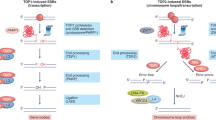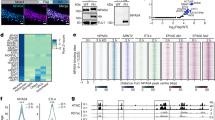Abstract
The ageing of the human brain is a cause of cognitive decline in the elderly and the major risk factor for Alzheimer's disease1. The time in life when brain ageing begins is undefined2,3,4. Here we show that transcriptional profiling of the human frontal cortex from individuals ranging from 26 to 106 years of age defines a set of genes with reduced expression after age 40. These genes play central roles in synaptic plasticity, vesicular transport and mitochondrial function. This is followed by induction of stress response, antioxidant and DNA repair genes. DNA damage is markedly increased in the promoters of genes with reduced expression in the aged cortex. Moreover, these gene promoters are selectively damaged by oxidative stress in cultured human neurons, and show reduced base-excision DNA repair. Thus, DNA damage may reduce the expression of selectively vulnerable genes involved in learning, memory and neuronal survival, initiating a programme of brain ageing that starts early in adult life.
This is a preview of subscription content, access via your institution
Access options
Subscribe to this journal
Receive 51 print issues and online access
$199.00 per year
only $3.90 per issue
Buy this article
- Purchase on Springer Link
- Instant access to full article PDF
Prices may be subject to local taxes which are calculated during checkout




Similar content being viewed by others
References
Yankner, B. A. A century of cognitive decline. Nature 404, 125 (2000)
Lee, C.-K., Weindruch, R. & Prolla, T. A. Gene expression profile of the aging brain in mice. Nature Genet. 25, 294–297 (2000)
Jiang, C. H., Tsien, J. Z., Schultz, P. G. & Hu, Y. The effects of aging on gene expression in the hypothalamus and cortex of mice. Proc. Natl Acad. Sci. USA 98, 1930–1934 (2001)
Blalock, E. M. et al. Gene microarrays in hippocampal aging: statistical profiling identifies novel processes correlated with cognitive impairment. J. Neurosci. 23, 3807–3819 (2003)
Kandel, E. R. The molecular biology of memory storage: a dialog between genes and synapses. Science 294, 1030–1038 (2001)
Malinow, R. & Malenka, R. C. AMPA receptor trafficking and synaptic plasticity. Annu. Rev. Neurosci. 25, 103–126 (2002)
Mao, Z., Bonni, A., Xia, F., Nadal-Vicens, M. & Greenberg, M. E. Neuronal activity dependent cell survival mediated by transcription factor MEF2. Science 286, 785–790 (1999)
Okamoto, S., Krainc, D., Sherman, K. & Lipton, S. A. Antiapoptotic role of the p38 mitogen-activated protein kinase-myocyte enhancer factor 2 transcription factor pathway during neuronal differentiation. Proc. Natl Acad. Sci. USA 97, 7561–7566 (2000)
Smith, D. S. & Tsai, L. H. Cdk5 behind the wheel: a role in trafficking and transport? Trends Cell Biol. 12, 28–36 (2002)
Tu, Y., Tornaletti, S. & Pfeifer, G. P. DNA repair domains within a human gene: selective repair of sequences near the transcription initiation site. EMBO J. 15, 675–683 (1996)
Tchou, J. et al. Substrate specificity of Fpg protein. Recognition and cleavage of oxidatively damaged DNA. J. Biol. Chem. 269, 15318–15324 (1994)
Lindahl, T. & Barnes, D. E. Repair of endogenous DNA damage. Cold Spring Harb. Symp. Quant. Biol. 65, 127–133 (2000)
Bruner, S. D., Norman, D. P., Fromme, J. C. & Verdine, G. L. Structural and mechanistic studies on repair of 8-oxoguanine in mammalian cells. Cold Spring Harb. Symp. Quant. Biol. 65, 103–111 (2000)
Athas, W. F., Hedayati, M. A., Matanoski, G. M., Farmer, E. R. & Grossman, L. Development and field-test validation of an assay for DNA repair in circulating human lymphocytes. Cancer Res. 51, 5786–5793 (1991)
Landfield, P. W. & Pitler, T. A. Prolonged Ca2+-dependent afterhyperpolarizations in hippocampal neurons of aged rats. Science 226, 1089–1092 (1984)
Longo, V. D. & Finch, C. E. Evolutionary medicine: from dwarf model to healthy centenarians? Science 299, 1342–1346 (2003)
Hekimi, S. & Guarente, L. Genetics and specificity of the aging process. Science 299, 1346–1351 (2003)
Hasty, P., Campisi, J., Hoeijmakers, J., van Steeg, H. & Vijg, J. Aging and genome maintenance: lessons from the mouse? Science 299, 1355–1359 (2003)
Murphy, C. T. et al. Genes that act downstream of DAF-16 to influence the lifespan of Caenorhabditis elegans. Nature 424, 277–283 (2003)
Ghosh, R. & Mitchell, D. L. Effect of oxidative DNA damage in promoter elements on transcription factor binding. Nucleic Acids Res. 27, 3213–3218 (1999)
Kyng, K. J., May, A., Kolvraa, S. & Bohr, V. A. Gene expression profiling in Werner syndrome closely resembles that of normal aging. Proc. Natl Acad. Sci. USA 100, 12259–12265 (2003)
Mecocci, P. et al. Oxidative damage to mitochondrial DNA shows marked age dependent increases in human brain. Ann. Neurol. 34, 609–616 (1993)
McCarroll, S. A. et al. Comparing genomic expression patterns across species identifies shared transcriptional profile in aging. Nature Genet. 36, 197–204 (2004)
Tusher, V. G., Tibshirani, R. & Chu, G. Significance analysis of microarrays applied to the ionizing radiation response. Proc. Natl Acad. Sci. USA 98, 5116–5121 (2001)
Xu, J. et al. Dopamine-dependent neurotoxicity of alpha-synuclein: A mechanism for selective neurodegeneration in Parkinson disease. Nature Med. 8, 600–606 (2002)
Acknowledgements
We thank G. Verdine and D. Gabuzda for discussions, and M. Yuan, S. Weninger, P. Stieg, P. Dickes, C. Geula and L.-W. Jin for assistance with procurement and dissection of tissue samples. We also acknowledge the Kathleen Price Bryan Brain Bank at Duke University, the Harvard Brain Tissue Resource Center, the Massachusetts General Hospital ADRC Brain Bank, the University of Washington Brain Bank, and the University of Maryland Brain Bank for providing tissue samples. This work was supported in part by grants from the NIH (NIA and NINDS) to B.A.Y. T.L. was supported by a fellowship from the National Institute on Aging, and S.Y.K. was supported by a fellowship from the Leukemia and Lymphoma Society.
Author information
Authors and Affiliations
Corresponding author
Ethics declarations
Competing interests
The authors declare that they have no competing financial interests.
Supplementary information
Supplementary Figure 1
Effects of limited oxidative stress and hOGG1 overexpression on cell survival. (PDF 176 kb)
Supplementary Figure 2
Knockdown of mitochondrial F1 ATP synthase α increases DNA damage. (PDF 239 kb)
Supplementary Table 1
Human brain samples (DOC 33 kb)
Supplementary Table 2
Age-regulated genes (XLS 84 kb)
Supplementary Table 3
Significance analysis of microarrays (XLS 867 kb)
Rights and permissions
About this article
Cite this article
Lu, T., Pan, Y., Kao, SY. et al. Gene regulation and DNA damage in the ageing human brain. Nature 429, 883–891 (2004). https://doi.org/10.1038/nature02661
Received:
Accepted:
Published:
Issue Date:
DOI: https://doi.org/10.1038/nature02661
This article is cited by
-
Long-run real-time PCR analysis of repetitive nuclear elements as a novel tool for DNA damage quantification in single cells: an approach validated on mouse oocytes and fibroblasts
Journal of Applied Genetics (2024)
-
The major TMEM106B dementia risk allele affects TMEM106B protein levels, fibril formation, and myelin lipid homeostasis in the ageing human hippocampus
Molecular Neurodegeneration (2023)
-
Long-term exposure to polystyrene microplastics triggers premature testicular aging
Particle and Fibre Toxicology (2023)
-
Somatostatin slows Aβ plaque deposition in aged APPNL-F/NL-F mice by blocking Aβ aggregation
Scientific Reports (2023)
-
Age, sex, and apolipoprotein E isoform alter contextual fear learning, neuronal activation, and baseline DNA damage in the hippocampus
Molecular Psychiatry (2023)
Comments
By submitting a comment you agree to abide by our Terms and Community Guidelines. If you find something abusive or that does not comply with our terms or guidelines please flag it as inappropriate.



